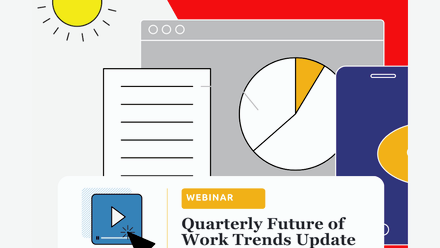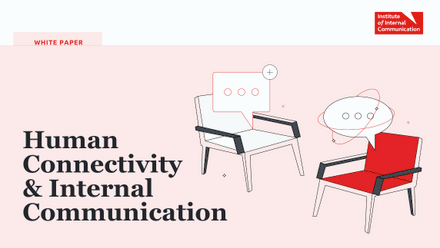Preparing for tomorrow's workplace
2019 is coming to a close, but instead of looking back and reflecting on the past year, industry experts are looking forward – and they’re not stopping at 2020.
The future of the workplace is a hot topic, but organisations are already feeling underprepared and overwhelmed.
To help IC professionals get their heads around it, IoIC’s latest roundtable brought senior internal communicators together to discuss Unily’s Future of the Workplaces 2030+ report. The research considers the future of work through four dimensions: emotional, physical, technological and purposeful.
The discussion led to some fantastic insights – and five key areas for IC professionals to consider when thinking about tomorrow’s workplace were identified.
1. Trust and honesty
If not already firmly established, trust and honesty within the workplace are key values that businesses should strive to champion and embrace in the future.
The roundtable group of IC experts established that many companies understand what is needed to foster an environment that embodies these values, but they’re yet to determine how to implement it.
It is often difficult to know how truth and honesty can be created and grown organically so that they become embedded within a business, and what capabilities are needed to put trust and honesty into action in a world of constant innovation.
Top takeaway: use digital tools to your advantage. Boost trust by creating social channels where people can interact.
2. Retaining staff
The group identified a common trend of young staff members leaving organisations after a few years.
Our practitioners put forward the following suggestions to help those looking to improve staff retention:
- Understand that the future of the workplace will look different for teams depending on the practicalities and requirements of their roles.
- Understand that boomerang employees will be the future. Employers should be open to their employees leaving the business and coming back with a more rounded perspective of the sector or other sectors.
- Don’t focus purely on young staff. We now work in an era that has four generations of employees working at the same time. Create a workplace that works for all by introducing cultural change programmes. A great example is Parkinson’s UK’s recent partnership with Barclays, which has been effective in bringing together employees across the organisation and empowering them within the business through the introduction of an entrepreneurial programme.
3. Culture
During the discussion, the topic of culture featured heavily – most notably, organisational culture. The roundtable group specifically looked at how organisations nurture this culture, which they defined as “what you do when people are not looking”.
Allowing your culture to grow organically through the behaviours and interactions of people, leaders and teams can be overwhelming and will take time, but, as IC professionals, it is our role to understand these dynamics when addressing our internal communication activities and, where possible, support them in order to create an effective culture that reflects employee sentiments.
The group shared how they were using consumer platforms to build connections. Instagram was recognised as successful for engaging with employees who are already using it socially. Our practitioners who had experience with this found that posting questionnaires and polls on Instagram attracted a higher interaction rate than other channels and helped them to connect and communicate through images and films. It also provided them with the freedom to communicate in an environment that suited remote and global cultures.
From a technological vantage point, it is also important that organisations, where able, provide employees with tools that will empower them and help them to work as effectively and creatively as possible.
Overall, aim to create a business culture that does not fear failure. This means being open to trying and testing new ideas and ways of working.
4. Transparency
Transparency was a key focus in Unily’s report. Many of the IC practitioners in the IoIC roundtable felt a key factor in determining the success of a business is the value it places on face-to-face interactions.
Many organisations use stories on platforms like Gamma to interact with employees, and create hashtags that connect people together within a business.
Communication has the power to create an open and innovative business environment, and the creation of a transparent roadmap allows all employees to understand the vision and strategy for the company in the future.
Top tips for improving transparency are as follows:
- Create curated social channels that look into different areas of a business, and create hashtags to connect employees.
- Host an open platform that allows all voices to be heard.
- Don’t underestimate the power of engagement – it is an important step towards transparency.
- Use platforms like Gamma to share stories and encourage interaction from employees.
5. Change
For change communication to work, it needs to be integrated within a business and adopted locally, but there is often uncertainty as to how a business should go about deploying change and whether it will be feared or accepted by employees.
It is clear that change will be a prominent and inevitable aspect of the future workplace, so internal communicators need to ensure they are equipped with the details and information they need to communicate it.
A central point of the group’s discussion on change was the influence of artificial intelligence and whether it will be positive or negative. Overall, our IC professionals agreed that AI will allow employees to remove mundane tasks and focus on being creative, which will ultimately be an incredibly beneficial factor for businesses in order to thrive.
Key to this, AI will:
- help professionals to filter work more efficiently
- be a more productive means for searching
- allow employees to be more innovative.
While looking at Unily’s Future of the Workplace report, the attendees discussed how change and internal communication will also create a productivity boost, but questioned whether this will be able to be quantified.
The group discussed how budgets will adapt when metrics are shown to create a positive change, and how soft and hard metrics will determine the effectiveness of change communication.
The future workplace has the potential to drastically transform organisations, and employers need to ensure they manage the implementation of changes effectively, in order to maintain, and hopefully improve, productivity.
Flexibility, a sound framework and a solid foundation will all be vital for the future, and each of these will lend itself to improving productivity and wellbeing.






